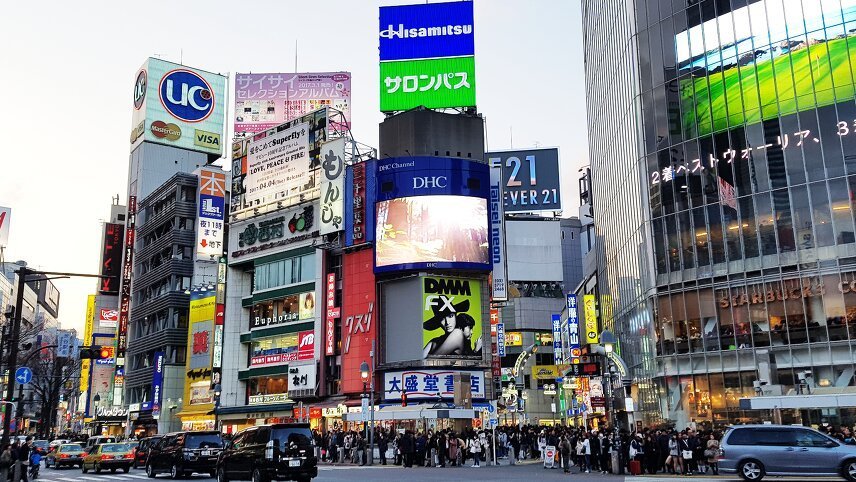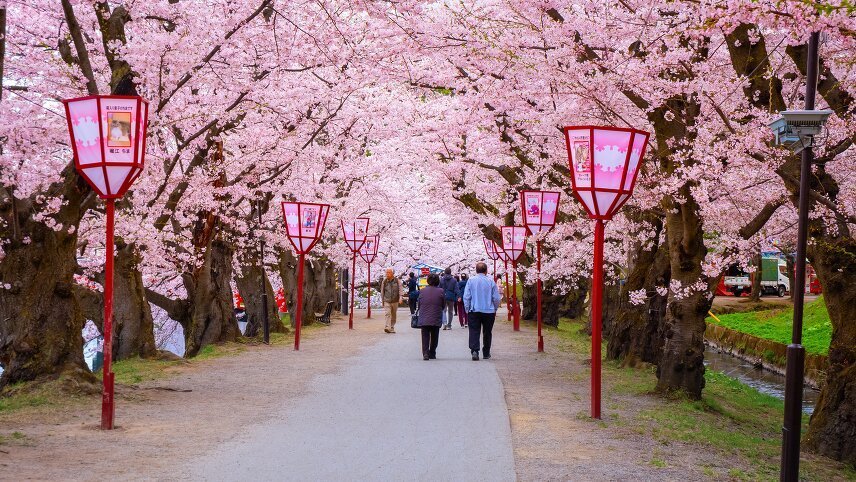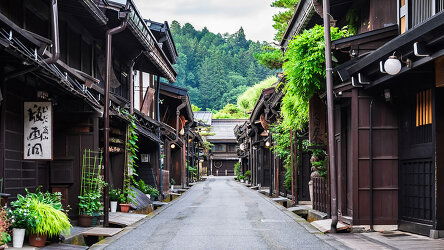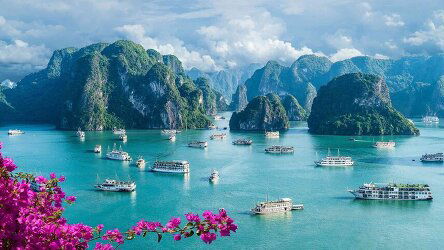Overview
Itinerary
Welcome to Japan and its buzzing capital, Tokyo. This fascinating country combines the ultra-modern with the ultra-traditional in such a way that it seems completely natural. A bit of everything can be found in Tokyo which makes this city such a unique place to explore.
We don’t want you to miss out on any aspect of your small group tour. To ensure that you don’t, we recommend you arrive by 5.30pm for a short briefing followed by dinner at the hotel. For those arriving in the evening and unable to attend the briefing and dinner, we’ll meet you the following morning when our touring begins as we start exploring Tokyo. Please refer to the letter you received upon check in with further details on the start time and your guide’s information.Old and new Tokyo is ours to explore today. Beginning in the Shibuya-Ku District, we will explore the Meiji Jingū Shrine, a Shinto shrine dedicated to the deified spirits of the Emperor Meiji and his wife, Empress Shōken.
Making our way across town, we will experience the neon lights and hustle and bustle of the famous Shibuya Crossing. Considered to be the busiest intersection in the world, over 1,000 people cross at a time during peak hours! Here, we'll have time to find a prime position for lunch and people watching in the many cafes and restaurants around the intersection.
Special Experience: Delve into a kaleidoscopic world of interactive art installations at TeamLab Borderless Digital Museum. This evening we board a Yakatabune, a typical Japanese-style houseboat from the Heian Era, where we’ll enjoy our highlight welcome dinner as we cruise along Tokyo Bay. Have your cameras ready, the views of the city skyline from the bay are really something!
Nicknamed the City of Trees, Sendai is the second largest city north of Tokyo. The regional city was founded around 1600 by one of Japan's most powerful lords at the time, Date Masamune. The tree lined streets and tranquil parks create a lovely atmosphere to explore the city.
We start our day with a visit to the final resting place of Tokugawa Ieyasu, who ruled Japan in the early 17th century. The Tōshōgū Shrine is a lavishly decorated shrine complex that consists of more than a dozen buildings set in a beautiful forest.
Next we'll travel to the picturesque Lake Chuzenji and Kegon Waterfall. One of the oldest national parks in Japan, it features diverse landscapes, natural hot springs, volcanoes and lakes.
All aboard Japan's famous bullet train, as we head to Sendai later this afternoon.
For centuries, Matsushima's iconic bay has been ranked as one of the country's most scenic views. Around 260 islands, large and small, are scattered throughout the bay, covered by pine trees, and light grey-coloured rocks. And there's no better way to take in this impressive natural landscape than on a leisurely Basho cruise. Journey through the deep green waters as we witness these unique and fascinating islands of Matsushima Bay.
Regarded as one of northern Japan's most important Zen Buddhist temples, Zuiganji Temple is our next stop today. Believed to date back to 828, the remaining buildings were constructed by the first lord of the Sendai Clan, Date Masamune. This ancient complex includes the main hall and Kuri (kitchen), both certified national treasures of Japan and a treasure museum displaying over 30,000 historical artefacts.
Traditional hand-painted wooden dolls called Kokeshi Dolls were first made in this area of Japan back in the late Edo Period, and today we'll get to experience painting one for ourselves! Next, we'll stop at the Aobayama Castle and Date Masamune Statue.
Special Experience: Experience the traditional cuisine of Sendai, with the opportunity of sampling the local delicacy, gyutan (beef tongue) at a special dinner.
At the easternmost point of the island of Honshu is Morioka, the capital city of Iwate Prefecture. Snow-capped mountains surround the city on three sides, providing a stunning backdrop to the city that three rivers flow through. The city is known for its delicious noodles - wanko soba, reimen and jajamen. After breakfast we'll make our way to Geibikei, a picturesque ravine on the Satetsu River, recognised as one of Japan's top three greatest gorges.
Special Experience: Admire the impressive waterfalls, rock formations and limestone caves of Geibikei Gorge on a scenic boat trip. Enroute to Morioka, we'll stop at the UNESCO World Heritage-listed Buddhist temple of Chūson-ji, believed to have been founded in 850 by the Tendai sect. The temple was built to placate souls of those that died in two major wars: the Zenkunen War (known in English as the Former Nine Years' War) and the Gosannen War (known as the Later Three-Year War). We'll also visit nearby Konjiki-do, a small building measuring 5 and a half metres on each side and 8 metres tall, which conveys an image of how Chūson-ji looked in its prime. Gold leaf covers the interior and exterior of the building, and the inside decorations reflect many aspects of the late Heian period arts and crafts, including mother-of-pearl inlays, woodwork, metalwork and lacquer work.
This evening we'll check into an authentic ryokan hotel which will be our home for the next two nights. This unique style of accommodation features tatami mat floors and serves authentic cuisine.
Here we will have the chance to bathe in a natural onsen (hot springs) and enjoy a traditional Japanese dinner.
We start our day by visiting Tezukuri-Mura, where we'll tour the Japanese Cultural Arts and Crafts village. Here we'll try our hand at indigo-dyeing using traditional techniques under the watch of skilled artists. This is a fantastic experience to learn more about the handmade products manufactured in the area, how they are made, and the level of skill required!
Next, we will explore the Morioka Castle Ruins Park. Construction on this three-story castle started around 1598 and was completed in 1633. During the Meiji period in 1874 – a time of great change for Japan – most of the structures in the castle were torn apart. In 1906 the castle ruins were repurposed into the park it is today, full of captivating gardens, rivers and shrines.
Special Experience: Take part in the local Wanko Soba tradition at a lunch in Morioka. These soba noodles originated in Morioka and Hanamaki, and are traditionally eaten in quick, small servings that are repeatedly refilled.
Now that you're sufficiently fed, it's time to wet your whistle with Japan's most famous beverage, sake! Touring the Asabiraki Sake Brewery we will learn the ancient process of cultivating rice to transform it into this tasty ‘Japanese liquor'.
This evening we'll make our way to Morioka City by bus to witness our first festival of the tour, Morioka Sansa Odori Matsuri (Festival). The festival celebrates the legend of a demon who was defeated by the god of Mitsuishi Shrine, swearing never to harm the people again. Watch as over 10,000 drummers and dancers in colourful costumes parade through the city, performing the traditional dance of Sansa Odori.
Located on the coast of the Sea of Japan is the Akita Prefecture, known for its hot springs, scenery and a well-preserved samurai district. Leaving Morioka this morning, we'll make our way to Akita via Kakunodate and Oga.
Special Experience: Explore the Aoyagi Samurai Manor Museum, discovering the rich history and way of life of the samurai and their wealthy families. Located on an almost 10,000 square metre estate, there are six galleries to explore, including the Main House, the Armory and a Samurai Tool Museum.
We then continue to the Shinzan Folklore Museum and the adjoining Namahage Museum, where we will learn about the fascinating legend of Namahage and the tradition of its yearly festival. In traditional Japanese folklore, Namahage are demon-like beings, portrayed by men wearing hefty ogre masks and traditional straw capes.
After an early dinner we will make our way on foot to Akita's incredible Kanto Matsuri (Festival). Best viewed at night, we'll witness the procession of performers showcasing their talents, dressed in traditional costume. Watch as nearly 250 bamboo poles are paraded high into the air, some nearly 12 metres, and carrying up to 46 candlelit, paper lanterns. A sight not to be missed!
The culturally rich city of Hirosaki, just south of Aomori, is our destination today. The cultural capital of the Aomori Prefecture, Hirosaki is home to impressive temples, stunning gardens and the well-known Hirosaki Castle.
We start our day with a visit to the Tsugaru Neputa Village to see the exhibits of local crafts and enjoy a shamisen live music performance.
Special Experience: Tour Hirosaki Castle and witness the breathtaking beauty of its Botanical Garden. Built in 1611 by the Tsugaru clan, the three-storey castle tower, its fortified moats, castle gates and some of the corner turrets, have stood the test of time, while others have been reconstructed. The Botanical Garden features 23 different zones, 124,000 trees and 1,500 species of plants.
Tonight, we'll dive into history as we enjoy the Hirosaki Neputa Matsuri (Festival), held in the old castle town of Hirosaki. Watch on as giant, illuminated floats adorned with vibrant images of warriors and beautiful women parade through the streets, celebrating the victorious return of troops from battle. Accompanied by flute and taiko (Japanese drum) players, the parade is a spectacular display of light and sound.
Sit back and enjoy the scenic drive through the beautiful Japanese countryside. We begin with a visit to the Oirase Gorge, one of the most beautiful river valleys in Japan. The Oirase stream flows from the crystal-clear waters of Lake Towada, creating a number of rapids and waterfalls that add to the gorge's beauty. The many waterfalls have been given colourful names, such as ‘Two Dragons Waterfall', ‘Happy Marriage Waterfall' and ‘Bead Curtain Waterfall'.
We then stop for lunch at a local restaurant with views Continuing, we will discover theof the majestic Lake Towada. The largest double-crater lake on the island of Honshu, it sits 400 metres above sea level and is over 320 metres deep.
We are in for another exciting night of festivities tonight. Making our way to the celebrations, we'll first stop at the A-Factory for a spot of shopping. Then, we're off to the famous Nebuta Matsuri (Festival)! Be transfixed as Aomori comes to life in a myriad of huge colourful, 3D floats. Be mesmerised by these human-shaped floats known as Nebuta, made from papier-mache and depicting historical characters, kabuki actors and ancient, mythical gods. Taking a whole year to design and construct, the floats are accompanied by large groups of taiko drummers and flute players, mixed with hundreds of Haneto dancers.
Travelling further north today, we make our way to Japan's Hokkaido Island and its third largest city, Hakodate. Situated between Hakodate Harbour and Tsugaru Strait, the city has played an important role in opening the country up to international trade and this international influence can be found in some of the city's architecture.
Beginning our day, we will visit the fascinating Sannai Maruyama Archaeological Site, from the Jomon Period (14,000-300BC). Discovered by accident, this former village once included more than 700 structures and dwellings.
Our journey on the bullet train to Hakodate today will speed underwater as well as through some of Japan's countryside. We will stop and visit Onuma Park, a quasi-national park known for the magnificent Mount Komagatake volcano surrounded by three main island-studded lakes. Several of these islands are connected by bridges, allowing visitors to explore more of the park, and we'll spend some time doing just that.
Goryōkaku Tower is our next stop. This tower, standing 107 metres tall, provides fantastic views of the beautiful star-shaped Fort Goryōkaku below, as well as Hakodate and its surrounds.
This evening, we'll take a ride on the Hakodateyama ropeway and enjoy fantastic views of the city and surrounds.
Today we'll explore more of Hakodate, starting at the Hakodate Morning Market with free time to explore the many different stalls.
Next we head to the Motomachi District at the foot of Mount Hakodate. Hakodate's harbour was one of the first to be opened to foreign trade in 1854 after Japan's era of isolation. As a result, traders from Russia, China and Western countries began to flock to Hakodate to live. Motomachi was a favourite spot among the new foreign residents, who brought their own architectural styles with them.
We'll then visit the Old Public Hall of Hakodate Ward where east meets west. Built in 1910, it is a prime example of elegant colonial architecture, which took place after the opening of Hakodate Port to foreign trade.
Making our way to the Kanemori Red Brick Warehouse, we'll uncover a quaint shopping mall consisting of four facilities, housing shops, restaurants and event spaces. Overlooking Hakodate Bay, it's a popular spot with locals and tourists alike.
The afternoon is then at leisure to further explore Hakodate.
Sapporo has everything you would expect from a large Japanese city (it's the country's fifth largest city by population) – vibrant neon-lit nightlife, fantastic food and plenty of shopping. The city is synonymous with snow too, in 1972 it became the first ever Asia city to host the Winter Olympics, and its annual Sapporo Snow Festival can see the city's populations double!
Today, we will travel by bullet train to Sapporo.
Continuing our travels, we will visit the Hokkaido Shrine. In 1869, by the decree of the Meiji Emperor, a ceremony was held to enshrine three pioneering kami (gods) to uplift the spirits of the pioneers. The shrine's construction began in 1870 in Sapporo and was officially erected in Hokkaido and named the ‘Sapporo Shrine'. The soul of the Meiji Emperor was later enshrined in 1964, at which point it was renamed to its current title, Hokkaido Shrine.
Here we will also explore the lively Nijo Fish Market.
Otaru is also famous for its glass, and today we will visit the original Kitaichi Glass Sangokan in a converted fishery warehouse. As well as a place to shop for souvenirs, it is also recognised for its grand hall lit with one-of-a-kind oil lamps.
Special Experience: Discover the history of beer making in Japan and the famous Sapporo Brewery at the Sapporo Beer Museum. Here we'll learn about one of Japan's most recognised beer brands, Sapporo, and their beer-making process. We'll enjoy a tasting of ‘Fukkoku Sapporo Bakushu', a unique beer brewed according to traditional methods dating back to 1881.
We’ll then return to the hotel before our group farewell dinner to celebrate our incredible tour.
Our tour concludes after breakfast this morning. We hope you leave with fantastic memories!
Trip Inclusions
- Tour the Meiji Jingu Shrine
- Experience Tokyo’s Shibuya Crossing
- Visit Team Lab Borderless Digital Museum - Please Note: Shoes will need to be removed to walk through water at one of the exhibits, please dress accordingly.
- Yakatabune dinner cruise around Tokyo Bay
- Explore Kegon Waterfall and Lake Chuzenji
- Cruise the Matsushima Bay
- Visit the Zuigani Temple
- Learn of the traditional Kokeshi Doll in Matsushima
- See the Aobayama Castle and the Date Masamune Statue
- Try the local delicacy of gyutan (beef tongue)
- Enjoy a scenic cruise along Geibikei Gorge
- Visit Chūson-ji Temple
- Spend two nights at an authentic Japanese Ryokan
- Visit Tezukuri-Mura and discover the Japanese art of indigo dyeing
- Tour Morioka Castle Ruins Park
- Take part in the local Wanko Soba tradition
- Enjoy a sake brewing experience at Asabiraki
- Visit Kakunodate Aoyagi Samurai Manor Museum
- Witness panoramic views of Oga and Mayama mountain range
- Visit the Namahage Museum, Shinzen Folklore Museum and Shinzan Shrine
- Enjoy a Shamisen performance and visit Tsugaru Neputa Village
- Wander through the Hirosaki Castle Botanic Gardens
- Stop at Oirase Gorge
- Travel to Lake Towada
- Visit the Sannai Maruyama archaeological site
- Explore the Onuma Park
- Free time to explore the Hakodate Morning Market
- Take in the panoramic views from Goryōkaku Tower
- Spend a full day exploring Hakodate
- Ascend Mount Hakodate via the Hakodate
- Visit Nijo Fish Market
- Taste Japan’s famous beer at Sapporo Beer Museum
- Stop at Hokkaido Shrine, dedicated to Shinto deities
- Explore Otaru Canal and visit Kitaichi Glass Sangokan
- Return economy-class flights from Australia to Japan. Taxes included
- Airport transfers on the first and last day of tour
- All touring in air-conditioned vehicles
- 3 Bullet Train journeys in Japan
- Tipping is not part of the Japanese culture, so tips are not expected
- 11 nights in 3-4 star hotels
- 2 nights in Japanese Style Ryokan accommodation in Tsunagi Onsen
- Grand Prince Hotel Shin (New) Takanawa, Tokyo
- Hotel Metropolitan Sendai East, Sendai
- Hotel Shion, Tsunagi Onsen (Morioka) - Japanese Style Ryokan accommodation
- Hotel Metropolitan, Akita
- Rockwood Hotel & Spa, Ajigasawa Onsen (Aomori)
- Century Marina Hotel, Hakodate
- Grand Hotel, Sapporo
- 13 breakfasts, 5 lunches and 8 dinners, including group welcome and farewell dinners
- English-speaking locally based national guide
- Accommodation, itinerary and inclusions subject to change.
- Disruptions to itinerary may occur.
- Shared bus transfers will be used between the hotel and the airport for the departure transfer.
- On days 4 and 11 we travel by bullet train, we will need to pack an overnight bag for the next two nights. Unfortunately, bullet trains have very limited space for luggage so our luggage will be transported separately and await us at our hotel two nights later.
- Minor renovations are being conducted to some of the buildings at Tōshōgū Shrine, but these should not affect our sightseeing. These renovations are due to end in 2024.
- Women may need a head scarf to enter some mosques and temples, and wear modest clothing that covers knees and shoulders. Also, a good tip is to pack a spare pair of socks in your daypack, as sometimes shoes need to be removed when entering and the ground can be hot.

Brochure

Bunnik Asia (2024-25)
Availability
A definite departure means minimum numbers have been reached for this departure to operate. Prices include air taxes and fuel surcharges, this amount is correct at time of brochure release and subject to change. Note air supplement may apply depending on airline availability and departure city. The majority of departures above will proceed or are guaranteed to depart (based on a minimum of 2 passengers). We will outline the status of your departure date in your quote along with all applicable discounts and specials.
Tour & cruises prices are per person. Prices shown have savings applied, are subject to availability and may be withdrawn at any time without notice. Prices and trip information are correct at the time at this point in time, however are subject to confirmation at the time of booking and are subject to change by Bunnik Tours. For cruise itineraries, cabin images are sourced from Bunnik Tours. These should be treated as indicative only. Cabin inclusions, upholsteries and room layout may differ to the image(s) shown depending on the ship selected and your sailing dates.









